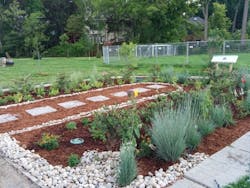Bring On the Rain
Students at Kenollie Public School in Mississauga, Ontario, Canada, are looking forward to the next rain storm. Credit Valley Conservation (CVC) teamed up with the school to build a rain garden on school grounds to collect and naturally filter rainwater.
The school grounds used to pond during heavy rain storms, leaving the playground a muddy mess. Certain areas often were so muddy that they became off-limits to students. The goal of the rain garden was to improve playground drainage and make the mud problem a thing of the past. The creation of a beautiful landscape feature that absorbs and cleans runoff and doubles as an educational resource for students was an added benefit.
Educators use the rain garden to teach students about the water cycle, biodiversity and how to care for the local environment. It is a key component of the school’s outdoor classroom, where students learn about the outdoors while outdoors. The rain garden also is a demonstration site for the Mississauga community, showcasing what residents, businesses and institutions can do to improve water quality and community flood resilience.
Rain gardens, a form of low impact development (LID), collect runoff and filter out pollutants so cleaner water can recharge local groundwater or flow into local creeks. They conserve a valuable and often disregarded source of water. The rain garden at Kenollie Public School absorbs surface runoff from the roof and paved surfaces before it enters Kenollie Creek, which drains directly into Lake Ontario.
The 26 students in the Kenollie Ambassador program ensure proper care and maintenance of the rain garden.
Building the Garden
Design and construction had their challenges. The goal of the rain garden was to filter runoff and promote infiltration and groundwater recharge. Impermeable clay soil made this difficult. To help infiltration, the rain garden was constructed 1.2 meters deep, and native soil was replaced with bioretention media and 0.75-in. clear stone.
Another concern was designing an effective storm water solution given the tight space on the school grounds. Engineers and integrated water management specialists designed a beautiful rain garden, able to handle a playground pounding and effective enough to eliminate ponding. The final design captures rainfall from a typical summer storm (25 mm of rain) from a catchment area of 0.33 hectare with a total water volume capture of 42 cu meters.
This rain garden also features a control valve that regulates the flow rate out of the garden. The valve can be raised or lowered to the desired outflow volume over a specific period of time. This means the rain garden can be manually adjusted to maximize rainfall and runoff capture. The control is raised in the summer when the school grounds are lightly used and storm events tend to be intense over short periods.
Once the operational components of the rain garden were in place, the team helped the students make the new feature their own. Kindergarten through sixth-grade students helped select garden plants while learning about climate change, extreme weather and drought. They selected species that are more resilient to weather extremes. The sixth-grade students were particularly concerned about southern Ontario’s shrinking monarch butterfly population, so they pushed for plants that will attract and sustain butterflies and other pollinators.
The students added their own artistic flair to the garden. They collected recycled materials and created sculptures of local wildlife. They also proudly incorporated their school mascot into the garden design.
The rain garden is constructed 1.2 meters deep, and native soil was replaced with bioretention media and 0.75-in. clear stone. A perforated pipe system helps with drainage.
Learning Continues
The rain garden, like any other garden, needs care and attention. Students in the Kenollie Ambassador program, established in the spring of 2017, ensure proper care and maintenance of the garden. Twenty-six children and two teachers take turns weeding. They also participate in events to educate their classmates and neighbors. Students were taught how to properly treat the garden and were reminded not to run through it because that compacts soils. They learned to save berries for the birds and to tell a teacher if they notice a lot of water or garbage in the garden. So far, the students are doing a great job of caring for their rain garden.
The rain garden at Kenollie Public School was funded in part by Intact Insurance and the University of Waterloo’s Climate Change Adaptation Program, RBC Blue Water Fund, TD Friends of the Environment, Port Credit Community Foundation, Tree Canada and Toyota Evergreen Learning Grounds.
The Ontario Ministry of Environment and Climate Change currently is updating its storm water management guidelines and will place greater importance on LID. As CVC continues to understand and discover innovative ways to manage storm water, its methods and technologies are constantly improving. CVC is a member of the Sustainable Technologies Evaluation Program (STEP), a partnership of conservation authorities working together to expand understanding of LID and provide training to organizations and individuals about leading-edge storm water technologies. STEP offers seminars on rain garden design and construction as well as a range of LID approaches.


